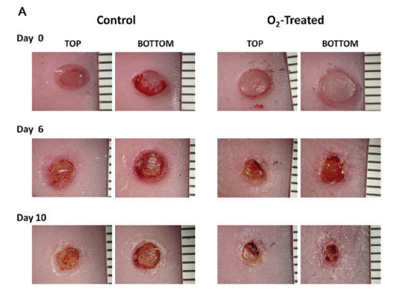Low flow oxygenation of full-excisional skin wounds on diabetic mice improves wound healing by accelerating wound closure and reepithelialization

ABSTRACT
Oxygen-based therapies have proven effective in treating chronic and difficult-to-heal skin wounds, but the current therapeutic approaches suffer from major limitations and they do not allow for continuous wound treatment. Here we examined whether the continuous treatment of wounds with pure oxygen at low flow rates accelerates wound closure and improves wound healing in a murine model of diabetic skin wounds. Two full-excisional dorsal skin wounds were generated on 15-week-old diabetic db/db mice and treated for 10 weeks continuously with pure oxygen (>99.9%) at low flow rates (3 ml/h). After 6 days, oxygen treatment resulted in a mean reduction of the original wound size by 60.2% as compared with only 45.2% in wounds on control mice that did not receive pure oxygen.(P = 0.022). After 10 days, oxygen-treated wounds were 83.1% closed compared with 71.2% in wounds on control mice. While reepithelialisation was complete after 10 days in over 57% of wounds receiving low flow oxygen treatment, significant epithelial gaps remained in 75% wounds from mice that did not receive oxygen. Continuous low flow oxygenation significantly improves healing of diabetic skin wounds in mice and may therefore be an effective treatment for chronic cutaneous and possibly other slow-healing wounds in diabetic patients.
